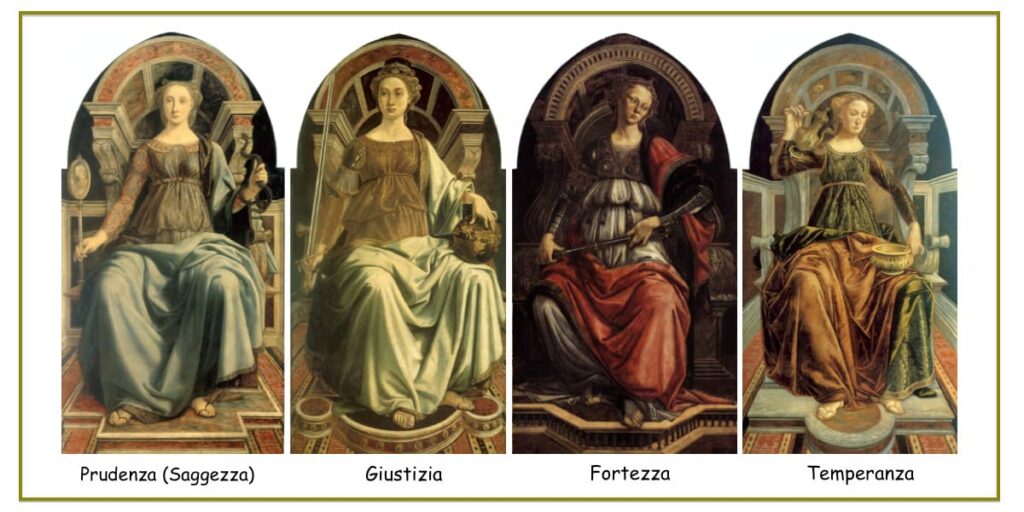
The Quadrumvirate of Virtues

The most famous images of the Virtues are the paintings by Pollaiolo and Botticelli, dating from the Renaissance (1470s) and preserved in the Uffizi Gallery in Florence. Each woman is depicted with objects symbolizing the characteristics of each Virtue.
The term VIRTUE comes from the Latin virtus -utis, meaning strength or courage, and from vir, meaning man or the nobility of man.
The word Virtue corresponds to the Greek areté, which has the same root as áriston/áristos, describing that which is the best. Virtue is that in which we can excel, our best way of being even before acting.
The quadrumvirate of Cardinal Virtues includes:
- Wisdom or Prudence
- Justice
- Fortitude or Courage
- Temperance or Moderation
They are called Cardinal Virtues because their function is pivotal (note: the Latin root of “cardinal”, cardo, literally means hinge). They are the main human Virtues, universal and independent of culture and religion, around which all others cluster.
Originally formalized by Plato (428–347 B.C.), this grouping is still valid today and has been taken as the basis of the scientific questionnaire, translated into all languages, the VIA Survey (http://www.viacharacter.org).
The Cardinal Virtues are abstract concepts that show the way forward, giving direction.
Each of these Virtues is an inner quality, present in each of us as latent potential which is not necessarily expressed. Each of us will express them according to our Uniqueness, with concrete actions and behaviors consistent with our Life direction.
Wisdom (or Prudence)
WISDOM or PRUDENCE is represented by a woman holding two symbols: a mirror on the left and a snake on the right. The mirror symbolizes prudence and introspection, meaning self-recognition through looking at one’s own face as well as one’s inner potential. The upright serpent on the left represents one who knows how to navigate around pitfalls and difficulties (due to self-knowledge!).
The term PRUDENCE comes from the Latin prudens, where pro means forward, and videns, which means seeing. Thus, it is a Virtue that prepares for the future, casting the gaze forward without rushing and learning from the past.
The term WISDOM corresponds to the Ancient Greek word phronesis, meaning knowledge that is useful for directing decision-making while maintaining a sound state of mind (sophrosyne).
Wisdom or Prudence represents the Virtue of discernment, that is, of being able to differentiate between and sift through what is useful and what is not… all of which depends on the grid of the “sieve”!
Today in business, a wise leader is one who looks towards the future, has broad horizons, and plays to his or her own strengths because he or she has journeyed into the self to reach a state that is “centered,” balanced and harmonious.
Justice
JUSTICE is represented by a woman holding a sword in her right hand, signifying punishment, while her left hand touches a globe resting on her knee, an augural symbol of the world to be ruled by her. She is also often depicted with scales as a sign of fairness, a lion to signify strength and a blindfold to indicate impartiality, freedom from the influence of what can be seen.
The term JUSTICE is derived from the Latin iustus, meaning just, and the Greek dikaiosýni meaning guidance, a directive to follow, fulfillment of the law, righteousness.
JUSTICE is a relational Virtue; it helps us relate better to others. This means having the ability to give everyone their due, not giving everyone the same thing! Justice can even be saying no.
According to Plato, being just—first and foremost towards oneself—requires alignment among the three dimensions we each have: head (rationality), chest (strength, irascibility), and heart (desire).
Acting with Justice today has the same meaning as it did back then, that is, acting from a head-chest-heart alignment.
Courage (or Fortitude)
COURAGE or FORTITUDE is represented by a woman wearing armor and a red cloak, the color of passion and commitment to fighting for and defending one’s ideals, even to the point of ultimate sacrifice. She holds a scepter, a symbol of the nobility and regalness of this Virtue and those who practice it.
The term COURAGE comes from the Latin cor, meaning heart. Also often referred to as fortitudo or Fortitude, it is the human Virtue which gives those who possess it a sense of serenity in facing risks, suffering, danger, uncertainty and intimidation.
The term FORTITUDE corresponds to the Ancient Greek word andreia, which gives us the prefix of scientific terms such as “andrology,” “androgynous” and “andropause,” as well as the proper name Andrew. The courageous man is the one who overcomes that fear.
Courage or Fortitude is the moral Virtue that ensures steadfastness and victory over fear in the face of difficulties. It is clearly distinguished from temerity or boldness, which entail taking risks for trivial ends or for the sheer pleasure of risk-taking.
What is Courage in everyday life? It is the human capacity to take risks for noble causes. It is taking on challenges. It is acting intentionally in view of reaching one’s goal.
Temperance (or Moderation)
TEMPERANCE or MODERATION is represented by a woman shown sitting on a large marble throne from a “wide-angle” perspective, mixing hot and cold water.
The term TEMPERANCE comes from the Latin temperantia, which means to measure out, to mix in the right measure, in the sense of moderation. It is discretion—the mother of all Virtues—and, in fact, Temperance also informs the other Virtues, making life harmonious.
Temperance or Moderation represents the Virtue of the golden mean, of sobriety, mastery and control of one’s instincts with balance rather than excess, and should be applied to ourselves first and foremost.
Temperance is the Virtue that enables you to know your own limits and set boundaries for yourself in line with the end you want to achieve.
What is the use of Temperance today, in everyday life? To help you achieve a happy medium between work and private life, finding your Work-Life Balance!
Author: Valentina Reiner
Valentina Reiner is Certified Business Coach (CBC™) by Worldwide Association of Business Coaches (WABC), European Individual Accreditation (EIA) Coach/Mentor at Senior Practitioner Level by European Mentoring and Coaching Council (EMCC), Neuromanager Positivo Applicato (NPA®) by Apprendo Academy

Sources:
Come superare la resistenza ai Cambia-Menti e trovare il proprio equilibrio Valentina Reiner, The Deeping, January 2021
The Performance formulas: what they are and how to implement them, Valentina Reiner, The Deeping, April 2022
The autotelic self, Valentina Reiner, The Deeping, June 2022
Purpose in Life is good for you!, Valentina Reiner, The Deeping, September 2022
